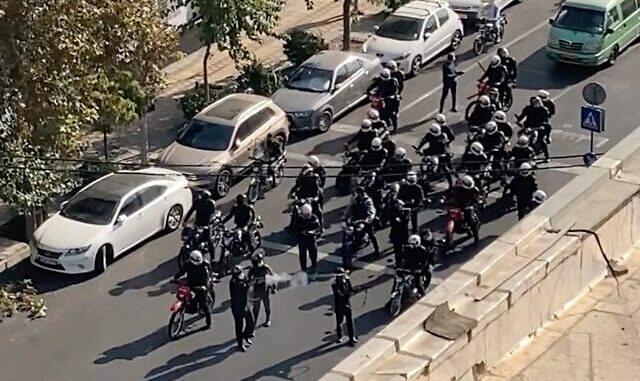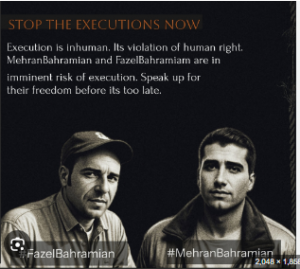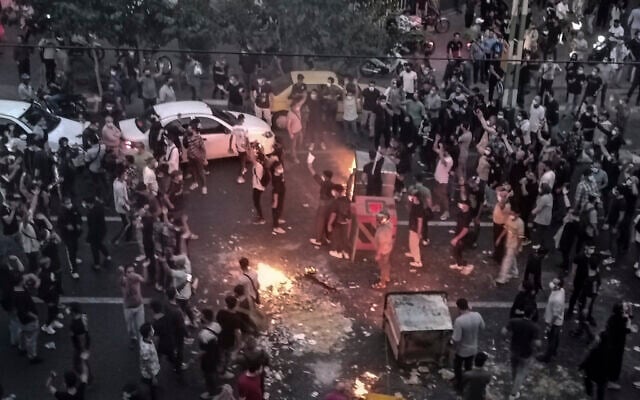
In this frame grab, from video taken by an individual not employed by The Associated Press and obtained by the AP outside Iran, Iranian police arrive to disperse a protest to mark 40 days since the death in morality police custody of 22-year-old Iranian Kurdish woman Mahsa Amini, in Tehran, Iran, October 26, 2022. (AP Photo)
Published September 7, 2025
Mehran Bahramian found to have been part of group that killed officer and wounded others in Isfahan amid wave of dissent after 22-year-old woman’s death in morality police custody
Iran executed Mehran Bahramian on Saturday, September 6, 2025, for his involvement in a deadly attack on security forces during the 2022 protests sparked by Mahsa Amini’s death. The judiciary’s Mizan Online reported that Bahramian was among a group of assailants who opened fire on a vehicle transporting security personnel in Semirom, Isfahan province, on December 31, 2022. The assault killed officer Mohsen Rezaei and left others wounded.

Bahramian was sentenced to death by the Revolutionary Court of Isfahan on charges of “moharebeh”—waging war against God—for his role in the shooting and allegedly encouraging attacks against state institutions. The Supreme Court upheld the verdict, and his execution was carried out in the early hours of Saturday morning .
This execution marks the 12th known case of a person put to death in connection with the 2022 protests, according to rights monitors. The demonstrations erupted after Mahsa Amini, a 22-year-old Kurdish woman, died in police custody following her arrest for allegedly violating the country’s strict dress code. The unrest led to widespread protests across Iran, with demands for greater freedoms and a rejection of the Islamic Republic’s rule.
Human rights groups have condemned Iran’s use of the death penalty in these contexts, citing secret trials, lack of evidence, and forced confessions. The United Nations has reported that Iran carried out nearly 1,000 executions in 2024, ranking among the highest globally.
👥 Public/Political Reactions
Iran’s recent execution of Mehran Bahramian on September 6, 2025, has elicited strong reactions from both domestic and international communities.
International Response:
-
Human Rights Organizations: Groups such as Amnesty International have condemned the execution, highlighting concerns over the fairness of trials and the use of the death penalty for politically motivated charges. They argue that such actions are part of a broader strategy to suppress dissent.
-
United Nations: A UN fact-finding mission has documented widespread human rights violations during the 2022 protests, including arbitrary detentions and executions without fair trials. The UN has called for accountability and cessation of such practices.
-
Global Governments: Countries like the United States and members of the European Union have expressed condemnation, urging Iran to halt politically motivated executions and improve its human rights record.
Domestic Response:
-
Activists and Citizens: Within Iran, activists continue to protest against the regime’s actions, despite facing repression. Social media platforms have been used to organize and voice dissent, though many accounts are subject to censorship.
-
Families of the Deceased: Relatives of those executed or killed during the protests have publicly mourned their loss and criticized the government’s actions, often facing further harassment or intimidation.
Iranians protest the death in custody of Iranian Kurdish woman Mahsa Amini, 22, after she was detained by Iranian morality police, in Tehran, Iran, September 20, 2022. (AP/ File)
⚠️ Resulting Effects
The execution of Mehran Bahramian and similar actions tied to the 2022 Mahsa Amini protests have several immediate and long-term effects on Iran’s society, politics, and international standing.
1. Domestic Climate of Fear and Repression:
-
The death penalty for protest-related offenses reinforces a climate of fear, deterring citizens from participating in demonstrations or publicly criticizing the government.
-
Activists, journalists, and ordinary citizens are increasingly cautious, limiting free expression and public dissent.
2. Escalation of Anti-Government Sentiment:
-
Despite repression, executions have fueled anger and frustration among protest supporters, particularly youth and ethnic minorities, including Kurds.
-
Memorials and social media campaigns for executed individuals serve as rallying points, sustaining resistance under tight surveillance.
3. Impact on Iran’s Legal and Judicial System:
-
The use of “moharebeh” (waging war against God) charges and expedited Revolutionary Court procedures highlights systemic issues in Iran’s judiciary.
-
International observers argue this undermines the rule of law, transparency, and credibility of the legal system.
4. International Relations and Sanctions Pressure:
-
Executions draw global condemnation, straining Iran’s diplomatic relations with Western nations and human rights bodies.
-
Potential for increased sanctions, trade restrictions, and isolation in international forums, particularly as the UN and EU monitor Iran’s human rights record.
5. Social Polarization:
-
Executions deepen societal divisions, pitting government loyalists against reformists and ethnic minority communities advocating for justice and human rights.
-
Long-term mistrust toward state institutions may hinder national cohesion and stability.
🔮 Future Outlook
The execution of Mehran Bahramian and ongoing suppression of dissent signal a complex and tense future for Iran, both domestically and internationally.
1. Continued Domestic Unrest:
-
Despite harsh crackdowns, public dissatisfaction—especially among youth, women, and ethnic minorities—is unlikely to dissipate.
-
The government may continue using force to suppress protests, but underground activism, social media campaigns, and small-scale demonstrations are expected to persist.
2. Government Crackdowns and Legal Measures:
-
Iran is likely to maintain or expand the use of “moharebeh” and other politically charged charges to prosecute protesters.
-
Surveillance, censorship, and intimidation may intensify, targeting both physical protests and online dissent.
3. International Pressure and Isolation:
-
Continued executions and human rights violations will keep Iran under international scrutiny.
-
Sanctions, diplomatic pressure, and condemnation from organizations like the UN, EU, and human rights NGOs may increase, potentially affecting trade and foreign relations.
4. Potential for Reform or Hardening of Regime:
-
The government may face a choice between incremental reforms to reduce unrest or doubling down on authoritarian measures.
-
History suggests that without meaningful reform, the cycle of protests and harsh government response is likely to continue.
5. Long-Term Social Impact:
-
Persistent repression could exacerbate brain drain, as educated and skilled citizens seek opportunities abroad.
-
Generational resentment may grow, leading to sustained societal divisions and undermining long-term national cohesion.
🧩 Bottom Line:
SOURCES: AP NEWS –Iran executes a man accused of killing a security guard in 2022 Mahsa Amini protests
SOUTH CHINA MORNING POST – Iran executes man accused of killing security guard in Mahsa Amini protests
KURDISTAN 24 – Iran Carries Out Death Sentence Over Security Officer’s Killing During 2022 Mahsa Amini protests






Be the first to comment